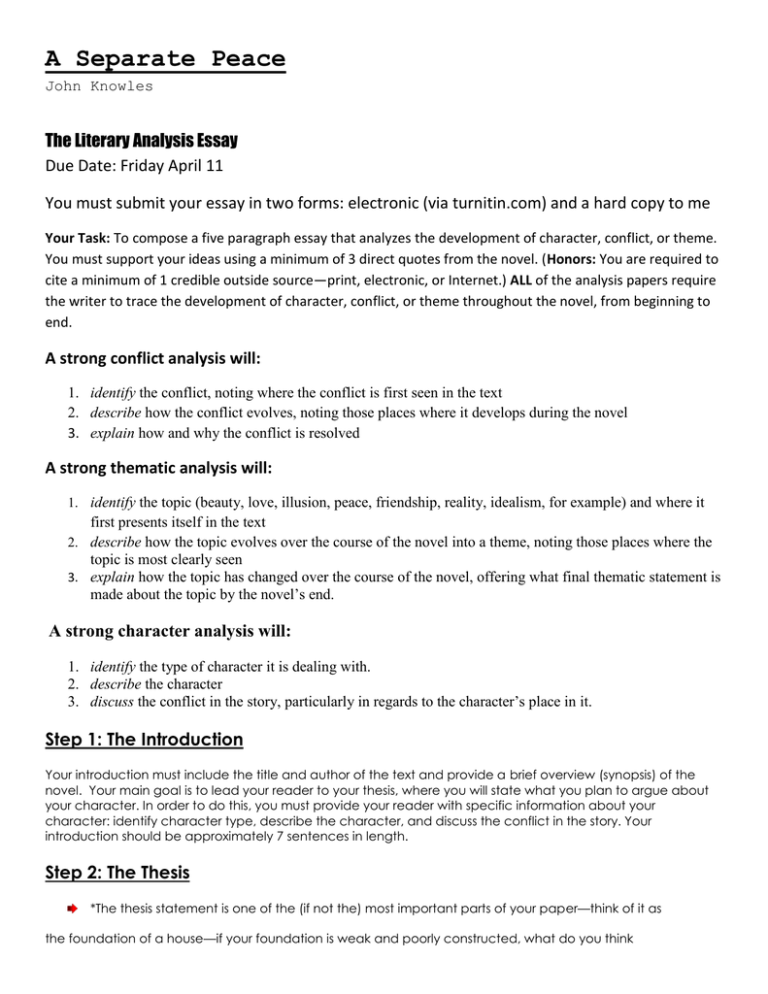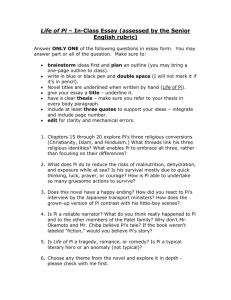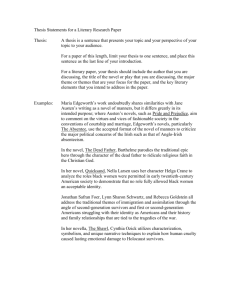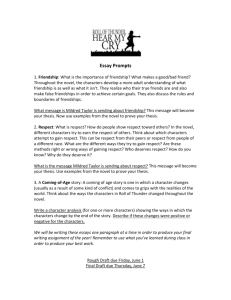peaceessaymodified
advertisement

A Separate Peace John Knowles The Literary Analysis Essay Due Date: Friday April 11 You must submit your essay in two forms: electronic (via turnitin.com) and a hard copy to me Your Task: To compose a five paragraph essay that analyzes the development of character, conflict, or theme. You must support your ideas using a minimum of 3 direct quotes from the novel. (Honors: You are required to cite a minimum of 1 credible outside source—print, electronic, or Internet.) ALL of the analysis papers require the writer to trace the development of character, conflict, or theme throughout the novel, from beginning to end. A strong conflict analysis will: 1. identify the conflict, noting where the conflict is first seen in the text 2. describe how the conflict evolves, noting those places where it develops during the novel 3. explain how and why the conflict is resolved A strong thematic analysis will: 1. identify the topic (beauty, love, illusion, peace, friendship, reality, idealism, for example) and where it first presents itself in the text 2. describe how the topic evolves over the course of the novel into a theme, noting those places where the topic is most clearly seen 3. explain how the topic has changed over the course of the novel, offering what final thematic statement is made about the topic by the novel’s end. A strong character analysis will: 1. identify the type of character it is dealing with. 2. describe the character 3. discuss the conflict in the story, particularly in regards to the character’s place in it. Step 1: The Introduction Your introduction must include the title and author of the text and provide a brief overview (synopsis) of the novel. Your main goal is to lead your reader to your thesis, where you will state what you plan to argue about your character. In order to do this, you must provide your reader with specific information about your character: identify character type, describe the character, and discuss the conflict in the story. Your introduction should be approximately 7 sentences in length. Step 2: The Thesis *The thesis statement is one of the (if not the) most important parts of your paper—think of it as the foundation of a house—if your foundation is weak and poorly constructed, what do you think happens to the house? *The thesis statement is the announcement of your analytical argument that you intend to make and prove in the duration of your paper. It is a road map for the paper—it tells the reader what to expect from the rest of the paper. *Your thesis statement should include two parts: WHAT and WHY. *WHAT: What claim are you making about the text? *WHY: Why should we care? Why is your claim important? Your thesis should answer the “so what?” question. *Your thesis may either be a single-point thesis or a three-point thesis. (Honors: You must compose a single-point thesis) Examples: Single-Point Thesis Throughout the course of the novel, Minnie changes from passivity to destructive assertiveness. A maturing Jem Finch explores traumatic situations throughout the novel, and even though he is disillusioned by the outcome of the Tom Robinson trial, his empathetic attitude still prevails. Although at times Dill Harris presents himself as confidently inquisitive, his thoughts and actions reveal him to be compassionate and lonely. Aunt Alexandra, the judgmental and authoritarian sister of Atticus Finch, does not reveal her compassionate side until after the children are attacked near the resolution of the novel. Scout Finch, the narrator of the novel, experiences turmoil in the town of Maycomb, Alabama as an innocent yet precocious young girl who proves herself to be the most dynamic of all characters. Three-Point Thesis: Throughout the course of the novel, Minnie changes from passivity to destructive assertiveness indicated by her clothing, her dead canary, and her unfinished patchwork quilt. As the novel progresses, Atticus presents himself as wise, courageous, and compassionate-- all qualities which make him an admirable leader of Maycomb. Despite the tremendous struggles Atticus Finch must endure throughout the novel, his actions and parenting capabilities consistently reveal a calm, compassionate, and judicious man. Arthur “Boo” Radley, the object of the children’s imaginations in the novel, presents himself as a victim of his father’s abusive personality and of the town’s gossip, an innocent man who cared for children, and a rescuer of those too helpless to defend themselves. Tom Robinson’s polite and honest personality leads to his victimization by the Ewells , the town, and the court system. Through Miss Maudie Atkinson’s open-mindedness, optimism, and compassion, she helps Jem and Scout better understand Atticus and their community. Step 3: The Body Paragraphs Each body paragraph should start with a topic sentence in which you state the point you will be developing within each paragraph. These should not be simply self-evident statements. There must be a point to them. And they must help prove your thesis. Example: (Thesis: Throughout the novel, the author clearly establishes Finn as a Christ-like figure, an omnipotent, all-forgiving, almost perfect being whose only goal is to preserve peace.) Body paragraph 1: Finn’s omnipresence is established early in the novel through the observations of Gene .) Then you should give examples from various parts of the novel to show that your topic sentence is true. You need a minimum of two, though three would probably be better. You should choose the best examples to show your point unless you need to use the same example to make another point. If the best example of Finn’s omnipresence is also the best one to show his perfection, then you have to make a judgment call. Determine which of the two is the weaker argument and use the best example for that argument, since it is the one that needs the most help. Do not use the same example to illustrate multiple points. Give just enough detail in your examples to make your point. Do not give too much detail; your teacher has read the book. Also don’t give so little information that your reader has to fill in your meaning. A body paragraph can end in many ways. The best, and the most difficult, is tying up the paragraph while leading into the next topic. Step 4: The Conclusion Due Dates: Introduction: _______________ Thesis: ________________ Body paragraph 1: __________________________ Final paper: April 11 (You MUST upload your paper to turnitin.com AND print out a hard copy to hand in at the start of class.) Grading will be based on the Masuk High School Response to Literature rubric. The Literary Analysis Essay Identify There are different kinds of characters. Characters can be protagonists (heroes), The main character around whom most of the work revolves. antagonists, The person who the protagonist is against. This is often the villain, but could be a force of nature, set of circumstances, an animal, etc. major, These are the main characters. They dominate the story. Often there are only one or two major characters. minor, These are the characters who help tell the major character’s tale by letting major characters interact and reveal their personalities, situations, stories. They are usually static (unchanging). dynamic (changing), static (unchanging), stereotypical (stock), This is the absent minded professor, the jolly fat person, the clueless blonde. foils, These are the people whose job is to contrast with the major character. This can happen in two ways. One: The foil can be the opposite of the major character, so the major’s virtues and strengths are that much “brighter” in reflection. Two: The foil can be someone like the major character, with lite versions of the major’s virtues and strengths so that the major comes off as even stronger. round (3 dimensional), This means the character has more than one facet to their personality. They are not just a hardcore gamer, but they also play basketball on the weekends. flat (1 dimensional), This is the character who is only viewed through one side. This is the hardcore gamer. That’s all there is to the character. Describe Consider the character’s name and appearance. Is the author taking advantage of stereotypes? The hot-tempered redhead, the boring brunette, the playboy fraternity guy. Is the author going against stereotypes? The brilliant blonde, the socially adept professor, etc Is the author repeating a description of the character? If so, then it is important. Is their name significant? Is it a word that means something, like Honor or Hero? Does it come from a particular place or time and make reference to that? Appearance and visual attributes are usually far less important than other factors, unless their appearance is the point– such as in The Hunchback of Notre Dame. Clothing also rarely matters, except to make him/her easier to visualize. Consider if he/she a static (unchanging) or dynamic (changing) character. If the character has changed during the course of the story: Was the change gradual or rapid? Was it subtle or obvious? Are the changes significant to the story or are they a minor counterpoint? Are the changes believable or fantastic? What was his/her motivation to change? What situations or characters encouraged the change? How does the character learn from or deal with the change? Consider how the author discloses the character: By what the character says or thinks. By what the character does. By what other characters say about him/her. By what the author says about him/her. The short form for this is STAR (says, thinks, acts, reacts). Look for these things within the creation of the character: psychological/personality traits Do these characteristics aid in the character being consistent (in character), believable, adequately motivated, and interesting? Do the characteristics of the character emphasize and focus on the character’s role in the story’s plot? motivation Is the character ethical? Is he/she trying to do the right thing, but going about it in the wrong way? Is the motivation because of emotion (love, hate) or a decision (revenge, promotion)? behavior /actions Does the character act in a certain way consistently? Or is the character erratic? Could one pluck the character from the story, put them in another story, and know how they would react? relationships With other characters in the story How others see/react to him/her weaknesses/faults Typical tragic weakness is pride. Oedipus is proud. Weakness could be anything. strengths/virtues There are many different strengths and virtues. One strength/virtue is being good in trying times, like Cinderella. Another strength/virtue is caring for family, like Little Red Riding Hood. Another strength/virtue is being smart, like Oedipus. Most protagonists have more than one strength/virtue. moral constitution Often a character will agonize over right and wrong. If a character doesn’t agonize and chooses one or the other easily, that is also significant. protagonist/antagonist Does the story revolve around this character’s actions? If so, is the character the hero (protagonist) or villain (antagonist)? complex/simple personality Personalities are more likely to be simple in children’s stories, fairy tales, and short stories. Personalities are more likely to be complex in longer works. Even in short works, such as “The Story of an Hour,” the character’s personality can be complex. Then it depends on what the author was focusing on. history and background Sometimes a character analysis looks at the history of the individual character. Was that person mistreated? abused? well-loved? liked? Sometimes the history of the work matters more. Is the story set in World War II? In ancient Greece? That makes a difference because culture changes stories. If you don’t know the culture, though, you may not be able to comment on this. similarities and differences between the characters This could be the foil aspect again. It could be looking at how characters complement each other. It could be looking at why characters would be antagonistic. character’s function in story Is the character an integral character? (Cinderella) Is the character a minor character? (The wicked stepmother in “Cinderella”) Is the character someone who could have been left out or is gratuitous? (The second wicked stepsister in “Cinderella.”) Discuss Conflict can be many things: External – man vs. man: This is the protagonist versus the antagonist. Snow White versus the Wicked Queen. man vs. machine: This is when the machine is the enemy. Many robot-centric novels have this issue. (This is sometimes considered a subset of man vs. man.) man vs. nature: Robinson Crusoe on the island. Hansel and Gretel lost in the forest. man vs. animal: Captain Ahab versus the white whale in Moby Dick. The wolf in “The Three Little Pigs.” –Usually the animal is a predator and the man has become prey for some reason. It could be humorous, though, the man is trying to catch the dog, who runs away and has the main character chasing him all over creation. (This is sometimes considered a subset of man vs. nature.) man vs. fate or destiny: Sleeping Beauty can’t help pricking her finger. A man who has been late several times (due to circumstances beyond his control) gets in a traffic jam and is an hour late to work and gets fired. The fact that it has happened several times and is not his fault is the crucial point. man vs. society: This is when a character battles societal norms. Winston Smith in 1984. Huck in The Adventures of Huckleberrry Finn. Internal – man vs. himself: This is when the character has an ethical dilemma, stealing to feed his family or watch them starve. Lie to the government and save the people in the basement or tell the truth and have them taken away. This is the cartoon equivalent of the devil and the angel on either shoulder. man vs. his mind: This is the character with internal problems that are not ethical, but mental. An example, as was pointed out in the comments, is the character with schizophrenia or one who is bipolar. How does the character deal with his/her limitations? What do they have to overcome? How do they overcome it? Is it harder or easier to overcome something that is a part of the character than it is to overcome something that is outside of the character?





